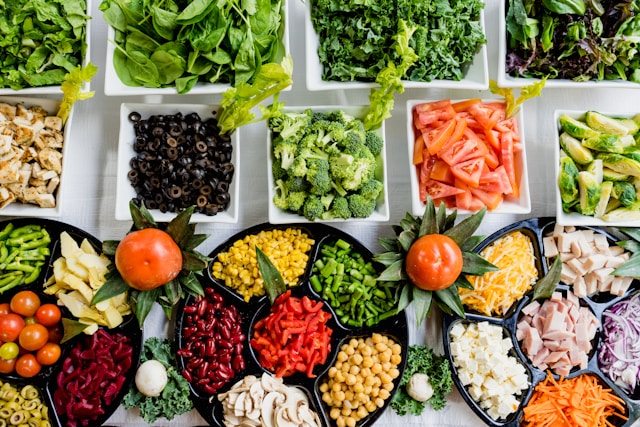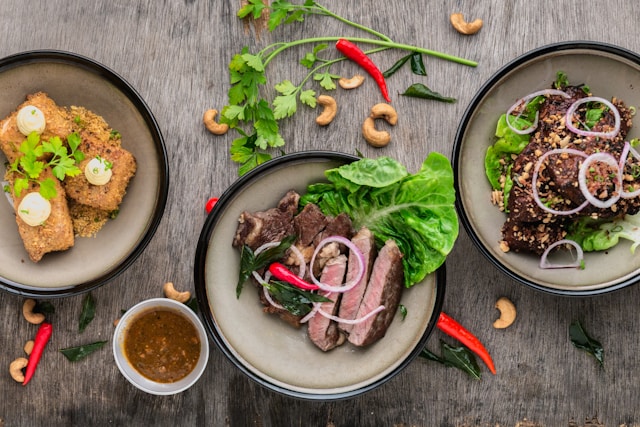Introduction
Ah, the slow roast leg of lamb – a dish that whispers tales of family gatherings, festive occasions, and the simple joy of cooking something with love and patience. This age-old delicacy, revered for its tender, succulent meat and rich, robust flavor, is more than just a meal; it’s an experience, a journey through taste and tradition.
Why Choose Slow Roast Leg of Lamb?
Before delving into the intricacies of preparing this exquisite dish, let’s delve into why the slow roast leg of lamb is a standout choice for any culinary enthusiast.
Unmatched Flavor
The slow roast leg of lamb is renowned for its unmatched flavor, which is the result of a meticulous cooking process that allows the lamb’s natural flavors to deepen and intensify.
- Slow Roasting Process: Through slow roasting, the lamb undergoes a transformative journey where its inherent flavors are coaxed to the forefront;
- Infusion of Juices: The prolonged cooking time allows the lamb’s juices to infuse every fiber, resulting in a dish that bursts with succulence and richness;
- Enhanced Seasoning: The gentle infusion of herbs and spices during the slow roasting process adds layers of complexity to the flavor profile, ensuring each bite is a symphony of savory notes.
Tenderness
Another hallmark of the slow roast leg of lamb is its unparalleled tenderness, achieved through the gradual breakdown of tough connective tissues during the prolonged cooking process.
- Collagen Hydrolysis: Through collagen hydrolysis, the tough connective tissues within the meat gradually break down, rendering it exquisitely tender with every bite;
- Melt-in-Your-Mouth Texture: The result is a melt-in-your-mouth texture that is nothing short of divine, offering a sensory experience that is unmatched by alternative cooking methods;
- Consistent Tenderization: Slow roasting ensures consistent tenderization throughout the entire cut of meat, guaranteeing a uniformly delightful dining experience.
Versatility
The slow roast leg of lamb stands out for its remarkable versatility, seamlessly fitting into a variety of culinary settings and meal occasions.
- Adaptable to Occasions: Whether it’s a grand celebration or an intimate family gathering, this dish effortlessly adapts to any culinary setting, elevating the dining experience with its timeless appeal;
- Pairing Options: From formal soirées to casual gatherings, the slow roast leg of lamb pairs beautifully with a wide range of side dishes and accompaniments, allowing for endless menu possibilities;
- Leftover Potential: Leftover slow roast leg of lamb can be repurposed into delicious sandwiches, salads, or pasta dishes, making it a versatile ingredient beyond its initial serving.
Selecting Your Leg of Lamb

The journey to a perfect slow roast leg of lamb begins at the market. When choosing your leg of lamb, consider the following:
Size Matters
When selecting your leg of lamb, it’s important to consider its size. Typically, a leg of lamb weighs between 5 to 7 pounds, making it ideal for feeding a family and leaving some delicious leftovers. However, larger legs of lamb can weigh up to 8 or 9 pounds, which may require longer cooking times and can be more challenging to cook evenly.
- A leg of lamb weighing between 5 to 7 pounds is recommended for most families;
- Larger legs of lamb, weighing up to 8 or 9 pounds, can be suitable for larger gatherings but may require adjustments in cooking time and method.
Bone-In or Boneless
Another crucial factor to consider when selecting your leg of lamb is whether you prefer bone-in or boneless cuts.
A bone-in leg of lamb often yields more flavor due to the bone marrow infusing the meat during cooking. Additionally, the bone helps the meat stay juicy by acting as an insulator. On the other hand, a boneless leg of lamb is easier to carve, making it more convenient for serving. It also tends to cook more quickly and evenly than bone-in cuts.
| Bone-In | Boneless |
|---|---|
| Yields more flavor due to bone marrow infusing the meat | Easier to carve, making serving more convenient |
| Helps meat stay juicy by acting as an insulator | Cooks more quickly and evenly than bone-in cuts |
| May require longer cooking times | May lack some of the flavor imparted by the bone marrow |
| Can be more challenging to carve | Ideal for those seeking convenience without sacrificing taste |
Preparing Your Lamb
When it comes to preparing a delicious leg of lamb, attention to detail in selecting the right ingredients and following proper cooking techniques is key. Here’s how to prepare your lamb for a mouthwatering roast:
Ingredients
Before you begin, gather the following ingredients:
- 1 whole leg of lamb (5-7 pounds);
- Fresh herbs such as rosemary, thyme, and parsley;
- Garlic cloves;
- Olive oil;
- Salt and pepper;
- Optional: red wine or broth for basting.
Instructions
Follow these step-by-step instructions to prepare your lamb:
- Preparation: Begin by patting the lamb dry with paper towels. This step is essential as it removes excess moisture from the surface of the meat, allowing the herbs and seasonings to adhere well;
- Seasoning: Generously season the lamb with salt and pepper, ensuring even coverage on all sides of the meat. Next, finely chop or crush fresh herbs such as rosemary, thyme, and parsley, and rub them onto the surface of the lamb. These aromatic herbs will infuse the meat with a delightful flavor during roasting. For an extra burst of flavor, create small slits in the meat using a sharp knife and insert slices of garlic into the slits. This allows the garlic to penetrate the meat, adding depth to the overall flavor profile;
- Marinating: While not mandatory, marinating the lamb for a few hours or preferably overnight in the refrigerator can further enhance its flavor. To marinate the lamb, place it in a large resealable plastic bag or a shallow dish, and drizzle it with olive oil. Add additional herbs and seasonings as desired, and massage them into the meat to ensure even distribution. Seal the bag or cover the dish with plastic wrap and refrigerate, allowing the lamb to marinate and absorb the flavors.
The Slow Roasting Process

Slow roasting is a cooking technique that involves cooking meat at a relatively low temperature over an extended period. This method is particularly popular for preparing lamb, as it allows the meat to become tender and develop rich flavors. Here’s a detailed guide on how to slow roast lamb to perfection.
Cooking Time and Temperature
Achieving the perfect slow-roasted lamb starts with setting the right temperature and cooking time. Follow these guidelines for optimal results:
- Temperature: Preheat your oven to 325°F (160°C). This low and slow approach is essential for breaking down the connective tissue in the lamb while allowing the flavors to develop slowly;
- Cooking Time: As a general rule of thumb, plan to roast the lamb for about 20 minutes per pound. For example, a 5-pound leg of lamb would take approximately 1 hour and 40 minutes to cook thoroughly. However, it’s essential to use a meat thermometer to ensure the lamb reaches the desired level of doneness. Aim for an internal temperature of 145°F (63°C) for medium-rare lamb and 160°F (71°C) for medium.
To ensure even cooking, consider using a roasting rack to elevate the lamb above the pan juices. This allows hot air to circulate around the meat, resulting in a more evenly cooked roast.
Tips for Perfection
To elevate your slow-roasted lamb to culinary perfection, consider incorporating the following tips:
- Basting: Basting the lamb during the cooking process helps keep it moist and infuses it with additional flavor. You can baste the lamb with its own juices or create a basting mixture using ingredients like red wine, garlic, and herbs. Use a basting brush to apply the mixture evenly over the surface of the lamb every 30 minutes or so;
- Seasoning: Before roasting, season the lamb generously with salt, pepper, and your choice of herbs and spices. A classic combination includes rosemary, thyme, and garlic, but feel free to get creative with your seasoning blend to suit your taste preferences;
- Resting: Once the lamb is finished roasting, resist the urge to carve it immediately. Instead, transfer the lamb to a cutting board and tent it loosely with foil. Let it rest for at least 15 minutes before slicing to allow the juices to redistribute throughout the meat. This resting period ensures a juicier and more flavorful roast;
- Accompaniments: While slow-roasted lamb is delicious on its own, consider serving it with a variety of accompaniments to complement its flavors. Roasted vegetables, creamy mashed potatoes, and a tangy mint sauce are all excellent choices that pair beautifully with lamb.
Carving Your Masterpiece

Carving a slow roast leg of lamb is an art in itself. Follow these steps for elegant, even slices:
Preparation
Before you begin carving, gather the necessary tools:
- A sharp carving knife: A long, thin-bladed knife is ideal for slicing through the meat with ease;
- A cutting board: Choose a stable surface to carve your lamb, preferably one with a groove to catch any juices;
- Kitchen towels: Keep towels nearby to wipe the knife between slices for clean cuts.
Positioning the Lamb
Place the cooked leg of lamb on the cutting board with the bone side facing up. If the lamb is bone-in, you’ll need to remove the bone before slicing.
Removing the Bone
If your leg of lamb is bone-in, follow these steps to remove the bone:
- Locate the bone: Identify where the bone meets the meat;
- Cut around the bone: Use your carving knife to cut along the bone, separating the meat from the bone;
- Release the meat: Once you’ve cut around the bone, gently pull it away from the meat to release it completely.
Slicing Technique
Now that your lamb is boneless and ready to carve, it’s time to employ the correct slicing technique:
| Point | Description |
|---|---|
| Maximizing Tenderness | To maximize tenderness and ensure a tender bite, always slice the lamb against the grain. |
| Understanding the Grain | The grain refers to the direction in which the muscle fibers run within the lamb meat. |
| Effect of Slicing Against the Grain | Slicing against the grain shortens these fibers, resulting in a more tender texture when consuming the lamb. |
Carving
Using your sharp carving knife, begin slicing the lamb against the grain into thin, even slices. Aim for slices that are approximately ¼ to ½ inch thick for optimal presentation and texture.
Presentation
Arrange the sliced lamb on a serving platter in an elegant and appealing manner. Consider garnishing with fresh herbs or a drizzle of jus for added flavor and visual appeal.
Serving
Once your masterpiece is carved and plated, it’s ready to be served to your eager guests. Enjoy the fruits of your labor and savor the exquisite flavor of slow-roasted leg of lamb.
Serving Suggestions
Complement your slow roast leg of lamb with sides that match its richness and depth. Some favorites include:
Roasted Vegetables
When it comes to complementing slow-roasted lamb, roasted vegetables are an excellent choice. The process of roasting enhances their natural flavors, providing a delicious contrast to the rich taste of the lamb. Consider incorporating the following options:
- Carrots: Roasted carrots bring a delightful sweetness and earthiness to the plate. As they caramelize in the oven, they develop a golden exterior while remaining tender inside;
- Potatoes: Roasted potatoes offer a satisfying texture with crispy edges and a fluffy interior. Seasoned with herbs like rosemary and garlic, they become infused with flavor, making them an irresistible side dish.
Roasting these vegetables alongside the lamb allows them to soak up its juices, resulting in a delectable and savory accompaniment.
Fresh Green Salad
A fresh green salad provides a refreshing contrast to the richness of slow-roasted lamb. It adds a burst of color and freshness to the meal while balancing its flavors. Here’s how to create a vibrant salad:
- Leafy greens: Mix lettuce, spinach, and arugula to create a diverse base for your salad. These greens offer a variety of textures and flavors;
- Colorful vegetables: Incorporate cherry tomatoes, thinly sliced cucumber, and diced bell peppers to add brightness and crunch to the salad.
Toss the salad with a simple vinaigrette made from olive oil, balsamic vinegar, Dijon mustard, and a pinch of salt and pepper to enhance the overall dining experience without overpowering the lamb.
Creamy Mashed Potatoes
Creamy mashed potatoes are a classic accompaniment to slow-roasted lamb, providing a comforting and indulgent side dish. Here’s how to make them:
- Start by boiling potatoes until they are fork-tender, then drain and mash them with butter and milk until smooth and creamy;
- Season the mashed potatoes with salt, pepper, and minced garlic for added flavor. For extra richness, consider adding cream cheese or sour cream to the mixture.
The velvety texture of mashed potatoes complements the tender meat of the lamb, creating a harmonious balance of flavors and textures on the plate.
Robust Red Wine
To elevate the dining experience further, pair your slow-roasted lamb with a robust red wine. The bold flavors of the wine enhance the richness of the lamb, creating a perfect harmony of taste. Consider these options:
- Cabernet Sauvignon: Known for its intense flavor profile of dark fruits, spices, and oak, Cabernet Sauvignon pairs exceptionally well with slow-roasted lamb;
- Merlot or Syrah: These full-bodied red wines also offer complex flavors that complement the savory notes of the lamb.
The tannins in red wine help cleanse the palate between bites, allowing you to fully appreciate the nuanced flavors of both the lamb and the accompanying dishes.
Conclusion
The slow roast leg of lamb is not just a dish; it’s a celebration of tradition, taste, and the joys of cooking. By following these tips and guidelines, you’re not just preparing a meal; you’re crafting an experience, one that will linger in the memories of your guests and in the comforting aroma in your home. Embrace the process, relish the flavors, and let the magic of the slow roast leg of lamb bring warmth and joy to your table. And for an equally delightful and heartwarming side, consider pairing it with a sweet potato pasta bake, a dish that perfectly complements the rich and savory flavors of the lamb. Together, these recipes create a symphony of tastes and textures that are sure to delight your palate.
FAQ
It’s best to thoroughly thaw your lamb in the refrigerator before roasting. This ensures even cooking and optimal flavor.
Using a meat thermometer is the most accurate method. For medium-rare, aim for an internal temperature of 135°F (57°C), and for medium, 145°F (63°C).
Absolutely! Feel free to experiment with different herbs and spices. Mustard, honey, and various spice blends can add unique twists to your slow roast leg of lamb.
Store leftover lamb in an airtight container in the refrigerator. It should be consumed within 3-4 days.
Yes, you can roast the lamb a day in advance. Reheat it in a low oven (around 300°F) until it’s warmed through.



